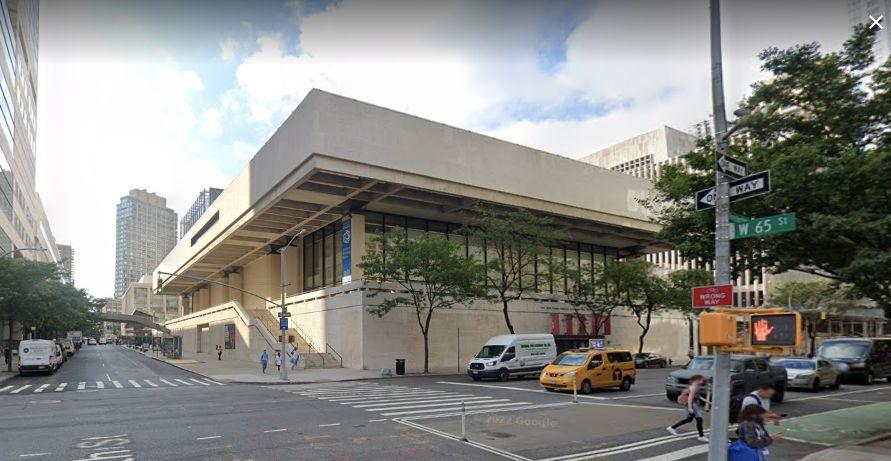
Viewing Lincoln Center from West 65th Street and Amsterdam Avenue (Google Maps)
Last June, Lincoln Center announced it would be redesigning the Amsterdam Avenue side of its campus in order to “break down barriers, physical and otherwise, between Lincoln Center and local community and audiences.”
Advertisement
Per a press release issued at the time, the performing arts venue added that it wishes to “explore how the Amsterdam Avenue side of the Lincoln Center campus can be made more accessible, welcoming and inclusive to create a greater sense of belonging.”
Lincoln Center has now announced that the design efforts will be led by Hood Design Studio, an Oakland-based landscape architecture firm; Weiss/Manfredi, an NYC-based multidisciplinary design practice known for Seattle Art Museum’s Olympic Sculpture Park; and Moody Nolan, the country’s largest African American-owned architecture firm.
Beginning its focus on Damrosch Park, where they plan to “deliver a major revitalization, providing open space for New Yorkers and state-of-the-art performance areas for artists from across the globe,” the team of designers and architects will be creating “proposals based on ideas and feedback from more than 3,400 New Yorkers who have participated in a robust and ongoing participatory planning process focused on making the campus more welcoming and accessible for all New Yorkers.”
Additional areas being considered for redesign include “the campus entrance at the northwest corner; as well as the New York Public Library for the Performing Arts terrace and Amsterdam Avenue entrance.”
Advertisement
Here’s some of the main feedback they gathered:
- The entrance should feel welcoming and be accessible, regardless of physical ability.
- There should be a dedicated area for “community performances where local talent can have a stage that is separate from the main stage.”
- There should be flexible exhibit spaces which display work from new talent and student artists, in addition to community-generated art.
- Greenery and sustainability should be prioritized.
- There should be food from different ethnicities and cultures, specifically at Damrosch Park.
Lincoln Center says it is still taking feedback from the public. Here’s a survey you can complete to share your thoughts.
According to a press release Lincoln Center issued on Monday, they will also be upgrading aging infrastructure including heating and cooling systems; power and data distribution; public and back-of-house restroom facilities; and access for the artists, audiences, and community members.
Lincoln Center was initially built in the 1950s during the Robert Moses era as part of a series of “urban renewal” projects that razed the nearby San Juan Hill community to make way for the arts center and other neighboring institutions. A huge swath of the area, home to more than 7,000 families and 800 businesses by mid-century—was razed in the 1950s as part of the project, called the Lincoln Square Development Plan.
Advertisement
The campus was ultimately designed with a fortress-like wall along Amsterdam Avenue, separating the neighborhoods to the west from Lincoln Center’s campus and making it largely inaccessible to foot traffic. A stark contrast to the iconic Revson Fountain and open plaza oriented to the east.
Here’s the main web page for the project. There’s currently no start date as they’re still in the beginning stages.


Again Im confiswd by Damrosch Park. Isn’t it public soace owned by the parks department (not Lincoln Center)? They list it on their website
https://www.nycgovparks.org/parks/M231/
While I’m sure the parks department likes someone else to foot the bill for improvements who gets to decide the plan?
Will Lincoln Center still be allowed to close Damrosch Park whenever Lincoln Center wishes? And no, I’m not talking about live music events at the bandshell, which close that section of the park. I mean LC treating the city park as their possession and staging grounds for whatever whenever.
Oh, and is the elevated part of the park above the ramps to the parking garage and the traffic circle under the plaza part of the park or part of the LC campus?
Yeah, let’s make the entrance across from the projects “more accessible.” For what? Will Cardi B be headlining opening night at the Met?
The Internet being the Internet, first comments are cynical and dismissive. Everyone should take heart that the fortress wall built astride Amsterdam Ave will be largely dismantled, that a new relationship will be fostered between the cultural center and the neighborhood that was mostly dismembered for its creation. I look forward to providing my input, however limited, and welcoming the enhancements ahead. We all hope the new design will meet our aspirations for a physical domain that matches the inspiring music, dance, opera and theater offered within.
Ok so to be fair, there’s only 2 blocks between Lincoln Center and the Hudson River. Also, they had to fit 3 massive buildings and chose to feature the Met. And all the transit is to the east so having the main entrance face east made perfect sense. The reason it feels so fortress like to the west is because of the grade of the streets, which required the Met to be significantly above Amsterdam Ave. Not every choice in our history is racist in origin.